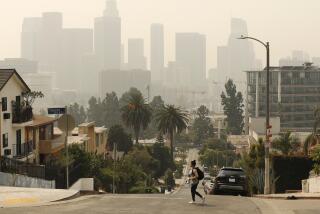EPA Mileage Estimates Running on Empty?
- Share via
Think you’re getting 26 miles to the gallon in that new car because the sticker said so?
Think again.
The city and highway mileage numbers on the windows of new cars are set by the Environmental Protection Agency. To determine them, the agency places a car on a machine like the kind used to perform smog checks, spins the wheels to simulate driving and measures emissions from the tailpipe to determine how much fuel was used.
But the test was developed 30 years ago, when driving habits and car engines were very different.
At the time, the national speed limit was 55 mph. So for the highway segment of the test, the car simulates driving at an average speed of 48 mph.
Today, the speed limit is 75 in some states -- and people tend to drive 80 or even 90 on long stretches of open highway. At those speeds, a car could burn through twice the amount of gas it would use at 48 mph.
The test assumes average speeds of 20 mph in city driving, which may not reflect the crawl of today’s commutes. That also can distort the test results, because the more a car stops and starts, the more fuel it uses.
“They’re testing driving the car gently and slowly, and people are driving faster and more aggressively,” said Steven Mazor, principal automotive engineer for the Automobile Club of Southern California.
Speed is not the only factor that can reduce fuel economy. For example, the EPA does not test cars with the air conditioner on. And the evaluations don’t reflect the fact that today’s more powerful engines allow motorists in stop-and-go traffic to accelerate much more quickly than they used to. Flooring the car to get onto the freeway, for example, can drop fuel economy down to 2 miles per gallon.
After years of complaints by the Auto Club, consumer groups and others, the EPA is rethinking the way it tests cars to determine fuel economy. According to spokesman John Millet, the agency is trying to figure out whether driving habits have changed enough since the 1980s to warrant a new test.
“We’re trying to see whether the sticker that’s on a new car is still a good estimate of what most people would experience when they drive,” Millet said.
It’s hard to say just how far off the federal agency’s numbers are -- if they are off at all.
Mazor said he once conducted an admittedly unscientific test in which he drove a car very quickly and aggressively, getting half the mileage that the EPA’s tests had shown for the vehicle. But, he said, people who drive cautiously may find that their results are fairly close to the EPA’s estimates.
The federal agency reduced its fuel economy estimates significantly in 1984 because of similar concerns that the test results labeled cars as more economical than they were. While keeping the test essentially the same, the EPA adjusted the results, shaving 10% off the city driving estimate and 22% off the highway estimate.
But consumer advocates and environmentalists say that’s not enough.
“Consumers are paying about $20 billion more [for gasoline] than they would be expected to pay just from looking at window stickers,” said David Friedman, a researcher at the Union of Concerned Scientists, an environmental group.
The EPA plans to spend the next year figuring out what habits most of us engage in most of the time and to use those in its new tests. For example, the agency could decide to run its tests with the air conditioner on part of the time or with a couple of hundred pounds of faux passengers in the back seat.
The automotive website Edmunds.com has compiled a list of driving habits that can reduce fuel economy. Among them: driving fast with the windows down (it ruins the aerodynamics of the car), driving a dirty car (also messes up the aerodynamics and can reduce fuel efficiency up to 7%), driving aggressively and carrying too much weight in the trunk.
Even driving around with your children in the car, making it heavier, can cause the vehicle to burn more fuel than the EPA sticker would indicate.
It’s hard, though, to really quantify how much individual driving habits affect a vehicle’s use of fuel. Certainly, drivers can calculate their own gas mileage by tracking the amount of fuel they put in the car and the number of miles they drive.
“You really have to look at your own driving habits and your own personal driving style,” said Ed Hellwig, senior road test editor with Edmunds.com.
“If you tend to drive on uncrowded highways, and you don’t drive aggressively, you can probably get fairly close to the [EPA] numbers,” he said. “If you know you drive more aggressively, expect that those numbers won’t apply to you.”






